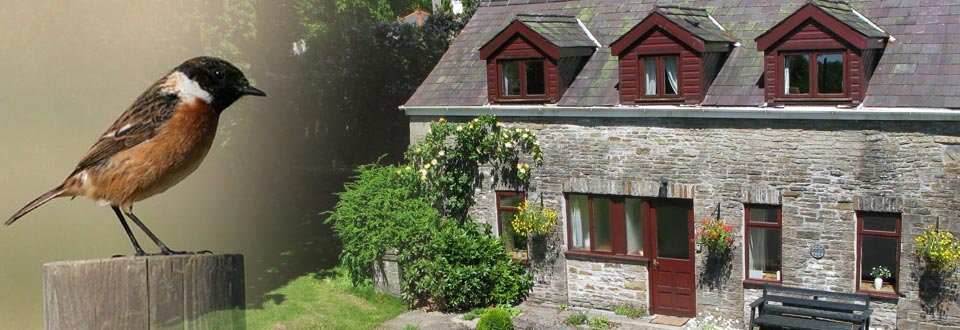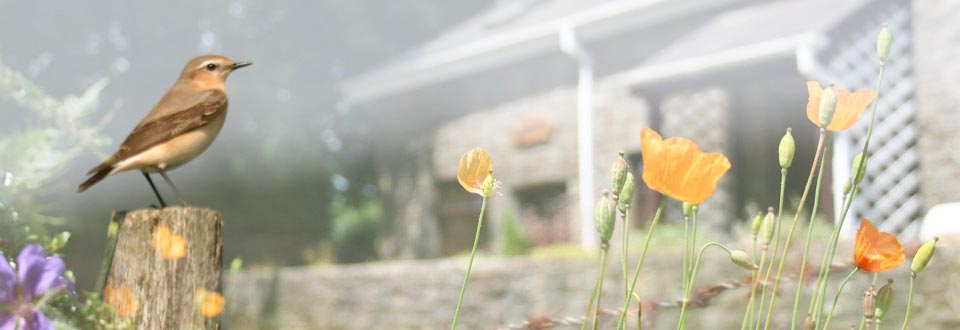Birdwatching Breaks
Swansea Valley Holiday Cottages are a popular countryside base for birdwatching breaks. The hillside farm is eight miles from the coast and contains a wide variety of habitats that provide our guests with wonderful birdwatching opportunities.

Baby birdwatcher in his hide at Plas Farm
- Around the cottages. Situated upon the bank of the upper reaches of the picturesque River Clydach – a haven for wildlife – herons, dippers, grey wagtails, trout and otters all live on the river.
- Around the farm. Green pastures and oak woodland give way to high moorlands with superb views of the South Wales countryside.
- Local RSPB Nature Reserve (Cwm Clydach) famous for its pied flycatchers, redstarts and dippers just five miles away.
- We are in Red Kite Country. The local feeding station is a spectacular 20 mile drive through the National Park from our holiday cottages.
- The National Wetlands Centre of Wales is 20 mins away – numerous hides look out onto the Loughor estuary, an inner lagoon and 500-acre wetland.
The most relaxing holiday ever”
The unique location of our self catering cottages means that our guests to enjoy a rare variety of birding opportunities. If you can tear yourself away from the cottage and farm (many have failed), then you could also include these places on your birding itinerary (all within 3o mins of our accommodation):
- Rarities abound at Kenfig Pool Nature Reserve. It’s coastal location makes it a natural magnet for migrants. There are two hides with a bewildering variety of species to be spotted.
- At Oxwich Marsh, extensive freshwater reed beds are home to reed and sedge warblers, grasshopper and cettis warblers, with bearded tit and water rail regularly recorded.
- Blackpill Mudflats, a twenty minuted drive from our cottages, is famous as the place where the UKs first ring-billed gull was found and is a must for any gull-watchers, particularly during the winter.
- Finally, a little further afield, but still an easy daytrip enjoyed by some of our guests is Ramsay Island RSPB Reserve – a boat trip will take you to see some of the finest wildlife and cliff scenery in Europe
Birdwatching Breaks in Wales
The Swansea Valley region is a delight to birding enthusiasts and those on a walking holiday as it consists of a number of habitats in a small area – a sandy coastal strip gives way rapidly to forested valleys surrounded by high moorland. The holiday cottages are located on the edge of a forested valley some 8 miles from the coast. A walk to the high moorlands behind the cottages gives wonderful views of Swansea Bay and Brecon Beacons National Park.
“Its peaceful, quiet and with sounds of nature everywhere. All we had to do was open our eyes”
Guests are free to roam over 120 acres of beautiful countryside of delightful contrasts, home to a wide variety of birds from stonechats to swallows and nuthatches to buzzards. Visitors to Wales are amazed to find buzzards so common. Indeed, in some areas of Wales, buzzards reach the highest population densities in the world. Wales is also famous as being the home of the red kite. The region that surrounds our self catering cottages boasts a mild climate due in measure to its proximity to the coast and the barrier against cold north winds created by the surrounding mountains.
Birding Holidays UK
Our holiday cottages provide an ideal countryside base for birdwatching breaks and walking holidays in the UK. The hillside farm is eight miles from the coast and contains a wide variety of habitats including an area of award winning broadleaved woodland, coniferous woodland, grassland, hedgerows and upland streams.
What birds will we see?
I. Around The Cottage
 The River Clydach is home to a wide variety of wildlife. Bird watchers will quickly spot the Grey Wagtail, running easily over the water-washed rocks or sitting, tail wagging, on a branch over the stream to watch for passing flies. Trout swim upstream in the summer and may be seen leaping out of the water to catch flies, although frequent visits by a Grey Heron keep them on their toes. Other birds such as Blue Tits, Great Tits and Long Tailed Tits are often seen flitting impatiently from branch to branch along the river bank.
The River Clydach is home to a wide variety of wildlife. Bird watchers will quickly spot the Grey Wagtail, running easily over the water-washed rocks or sitting, tail wagging, on a branch over the stream to watch for passing flies. Trout swim upstream in the summer and may be seen leaping out of the water to catch flies, although frequent visits by a Grey Heron keep them on their toes. Other birds such as Blue Tits, Great Tits and Long Tailed Tits are often seen flitting impatiently from branch to branch along the river bank.
“Had breakfast outside and watched the wildlife”
The gardens and lawns that surround the cottage are home to a number of beautiful species. One year, a pair of Greenfinch nested in a dwarf conifer outside the cottage, pied wagtails and swallows nest in the cottage eaves. Chaffinch are numerous and the brief accelerating song of the male will become very familiar to visitors to the holiday cottage as will the delightful sight of a Goldfinch. A charm of goldfinches, flitting through the swaying thistleheads, filling the air with liquid twittering, is an enchanting sight. Other birds regularly spotted around the cottage include Swifts, Coal Tits, Nuthatches, Sparrows, a Green Woodpecker and on some evenings, a Tawny Owl. At twilight you may see the jerky fluttering of a Pipistrelle Bat as it catches insects by moonlight over the River, making short sorties from a roost in the farmhouse loft.
“Jangled nerves calmed as always by tinkling of the Clydach, birdsong and batwatching. I want to live here. No, really.”
Mynnydd March Hywel mountain provides a striking backdrop to the cottages. Buzzards are often seen from the cottage patio, soaring over the fields and woods on their broad rounded wings. They usually appear singly or in a pair but sometimes as many as five or six may be seen, circling, floating and spiraling higher and higher in a favourable up-draft.
“Had a fantastic week in this lovely, cosy and romantic holiday cottage. And the best bit? Waking up to the birds chirping and the beautiful river which can be seen from the window”
II. On The Mountain
 Mynydd Marchywel (Hywel’s Stallion) is a broad sandstone ridge some 1371 feet high. The summit may be reached on foot in an hour, although most walkers take a lot longer as the views are so good.
Mynydd Marchywel (Hywel’s Stallion) is a broad sandstone ridge some 1371 feet high. The summit may be reached on foot in an hour, although most walkers take a lot longer as the views are so good.
“Walking to the top of the mountain was wonderful. It took us about half an hour to reach the top of Plas Farm from the holiday cottage. We rested there and enjoyed the superb views of Pontardawe and the Swansea Valley before continuing through forestry owned moorland. We soon saw a pair of Buzzards – perhaps the same pair we had seen from the cottage, soaring on almost motionless wings, wheeling around in large circles above the prehistoric stone cairns that crown the mountain. Our attention was soon captured by the lively, sustained chirruping of a Skylark, circling with fluttering wings for several minutes before finally dropping silently to earth. As we walked through the sheep grazed fields on the edge of a forestry plantation, we saw several Meadow Pipits rising from the grass and descending parachute-like on stiffly spread wings a little further away. But the best was yet to come. As we rounded an area of young conifers we saw a Cuckoo perched on a fence post, being fed by a Meadow Pipit. It is a rare sight and one we will always remember.
We continued to the summit where we found the prehistoric stone circles and enjoyed splendid views of the Bristol Channel and Swansea Bay to the South and Brecon Beacons National Park to the North. On our return journey the mountain had one treat left in store for us. As we entered the upper field of Plas Farm, we heard a harsh “tchack tchack”. We soon spotted the source of the noise – a pair of Stonechats sitting on a fence and periodically fluttering down to the grass for insects. It was a splendid day of birdwatching and we cannot wait to return.”
Red Kites are spotted flying above the cottages from time to time. Mynydd Marchywel is also home to a pair of Goshawks that breed in the forestry.
III. The Farmyard and Paddock
 The farm buildings are a haven for perhaps our best loved summer visitor, the Swallow. Having spent the winter in Africa, individual swallows return to nest in our sheds and outhouses, often making for the shed in which they were reared. The twittering song, often uttered as the bird perches on a wire outside the cottage or in a courtship chase through the farmyard, is particularly sweet and attractive. Parties of Swifts are often seen swooping gracefully in the sky above the swallows.
The farm buildings are a haven for perhaps our best loved summer visitor, the Swallow. Having spent the winter in Africa, individual swallows return to nest in our sheds and outhouses, often making for the shed in which they were reared. The twittering song, often uttered as the bird perches on a wire outside the cottage or in a courtship chase through the farmyard, is particularly sweet and attractive. Parties of Swifts are often seen swooping gracefully in the sky above the swallows.
The farmyard is also a favourite haunt of the Pied Wagtail which may be spotted taking a short bounding flight up to the roof of the cowshed, running nimbly along, and fluttering up to take the dancing midges. Later in the year, the cowshed roof may be occupied by a flock of Starlings, displaying their extraordinary medley of whistles, squeaks and chattering noises. They add to the effect by flapping their wings as they sit, singing away.
Come evening, take a short stroll onto the paddock outside the holiday cottage and it is likely that you will see a Song Thrush hoping around amongst the mole hills looking for worms, or twittering Swallows swooping low amongst the idle cows and chirrupping House Martins chasing insects. The trees that surround the fields are often occupied by members of the crow family – the “krah” of a Crow and “chak” of a Jackdaw are often heard. Occasionally, a Pheasant will be seen wandering aimlessly and following rain, it is not unusual to spot a pair of Mallards, standing in a large puddle that forms in a slight hollow in the field.
Bluebells underneath, blue skies above. Blue haze on the horizon “ wonderful days.
IV. The Oak Woodland
 Visitors are free to roam a six acre area of broadleaved woodland through which the River Clydach flows. We run an ongoing rhododendron clearance program within the woodland to prevent loss of habitat and ensure regeneration of the woodland. Native species such as bluebells, honeysuckle, hazel and holly spread into the previously densely shaded areas of the woodland. We have placed oak benches in the bluebell woodland for walkers and are currently installing bird nesting boxes to encourage the bird population. Rare varieties of rhododendron, in varying shades of red, pink and white have been spared and may be enjoyed by May/June visitors taking a riverside walk to the woodland. We are grateful to all our cottage guests who enjoy birdwatching breaks as they help us to identify new species within the woodland, be they birds, trees, wild flowers, grasses, fungi or other animals.
Visitors are free to roam a six acre area of broadleaved woodland through which the River Clydach flows. We run an ongoing rhododendron clearance program within the woodland to prevent loss of habitat and ensure regeneration of the woodland. Native species such as bluebells, honeysuckle, hazel and holly spread into the previously densely shaded areas of the woodland. We have placed oak benches in the bluebell woodland for walkers and are currently installing bird nesting boxes to encourage the bird population. Rare varieties of rhododendron, in varying shades of red, pink and white have been spared and may be enjoyed by May/June visitors taking a riverside walk to the woodland. We are grateful to all our cottage guests who enjoy birdwatching breaks as they help us to identify new species within the woodland, be they birds, trees, wild flowers, grasses, fungi or other animals.
“Gorgeous surroundings. Spotted 41 bird species plus bats, squirrels, a fox and a bank vole.”
“Our walk to the woods began at the weir, some 20 yards from the holiday cottage. Here we spotted between ten and fifteen brown trout swimming in the pool below and a grey wagtail bobbing around at the top of the weir. As we continued along the river bank, we passed some enormous beech trees in which we spotted a pair of nuthatches, plucking aggressively at the moss coated branches. We then walked through a yew tree archway and past some badger sets before stopping to rest on an oak bench on the river bank to enjoy the tranquility. Within a few minutes we saw a pair of spotted flycatchers perched on a prominent dead branch, their upright stance and pale breasts looking unfamiliar at first, but a quick twisting flutter after a passing insect soon gave them away. A speckled wood butterfly fluttered past. The males occupy sun-flecks as territories, while the females fly high in the canopy, choosing from the dancing males illuminated beneath them. A squawking jay disturbed the peace temporarily and a mouse like wren captured our attention as it crept along the forest floor searching for insects. We also saw some beautiful wild flowers including red campion, birds foot trefoil and a splendid yellow flower on the river bank that we identified as yellow archangel.”
I was attracted in the direction of the old pond area by the unmistakable song of a chiffchaff. It was perched high above the flowering rhododendrons on a prominent dead branch belonging to a tall Sycamore tree. Having failed to locate the source of a repetitive warbling song coming from the bushes, I ventured into the woodland. A male bullfinch landed on a rotting stump some 10 feet from the path and a female blackcap moved among the branches of a sweet chestnut, hard to see amongst the growing foliage. I saw a nuthatch, a pair of spotted flycatchers, a chaffinch, a blue tit and a pair of great tits before stopping at the oak bench. I sat listening to the stream and looking into the woodland. A treecreeper spiraled its way up a big oak tree on the other side of the river. I crossed upstream and walked through the bluebells towards the Norway Spruce plantation. I stopped to watch a thrush in full song on the stone wall that bounds the woodland. On my return to the holiday cottage, I couldn’t resist popping back to the old pool area. I was suprised to see and hear (for the first time) three buzzards having some sort of a disagreement before they dropped behind the trees. I have never been that close to buzzards in the wild and it was great.”
A cosy cottage in a fairy-tale surrounding. Well, its overwhelmingly beautiful: hedges, meadows with animals, woods with bizarre trees, ferns and mosses. And an abundance of flower species, a little further, rocks, waterfalls, ruins, mountains, the sea. And after a fascinating field trip you return home to a cosy shelter where in the night the owls are hooting¦ thanks!




